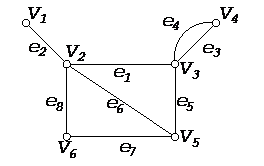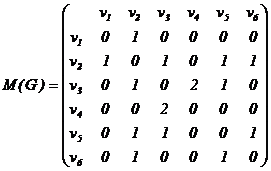图的邻接矩阵表示
表示 邻接矩阵
2023-09-27 14:28:46 时间
图的邻接矩阵表示 Adjacency Matrix of the Graph 一、邻接矩阵定义
拓扑排序(图的宽搜应用) 在图论中,拓扑排序(Topological Sorting) 是一个有向无环图(DAG, Directed Acyclic Graph) 的所有顶点的线性序列。
C++实现图 - 05 拓扑排序 今天来讲另一个非常重要的知识点 —— 拓扑排序。咋一看好像是一个排序算法,然而它和排序扯不上半点关系,它可以用于判断我们的图中是否存在有向环。
C++实现图 - 04 最短路径 今天我们来看看图论中另一个非常重要的问题 —— 最短路径,正如其名就是要再图中找到起点到终点的最短路径,这就需要不断地去比较每条边的权值。这一讲我们将会具体介绍迪杰斯特拉算法和弗洛伊德算法的实现。
【32. 图中的层次(图的广度优先遍历)】 - 因为所有的`边长都为1`,所以可以使用`宽度优先搜索`的思想,每当队列pop出一个元素时,将其距离为1的节点都加到队列中(层次遍历思想) - `st[]`标记各个节点有没有走过,`d[]`保存1号节点到各个节点的距离,初始时都为-1。
图的邻接矩阵定义:设图G=(V, E)的顶点集为V(G)={v1, v2,v3,…,vp},用aij表示G中顶点vi与vj之间的边数,则n阶方阵M(G)=(aij)pxp称为G的邻接矩阵(Adjacency Matrix)。

上图所示的图的邻接矩阵如下:

图的邻接矩阵有以下明显的性质:
l 邻接矩阵是一个对称矩阵;
l 若图G为无环图,则M(G)中第i行(列)的元素之和等于顶点的度数;
一般说来,图的邻接矩阵比它的关联矩阵小得多,通常图就以其邻接矩阵的形式存贮在计算机中。
二、图的邻接矩阵表示法的程序实现图的邻接矩阵表示法的数据结构为:
1: typedef struct SArc
2: {
3: double dWeight;
4: }AdjMatrix[VERTEX_NUM][VERTEX_NUM];
5:
6: typedef struct SGraph
7: {
8: int iVertexNum;
9: int iArcNum;
10: int aVertex[VERTEX_NUM];
11: AdjMatrix mArcs;
12: }Graph;
.csharpcode, .csharpcode pre font-size: small; color: black; font-family: consolas, "Courier New", courier, monospace; background-color: #ffffff; /*white-space: pre;*/ .csharpcode pre { margin: 0em; } .csharpcode .rem { color: #008000; } .csharpcode .kwrd { color: #0000ff; } .csharpcode .str { color: #006080; } .csharpcode .op { color: #0000c0; } .csharpcode .preproc { color: #cc6633; } .csharpcode .asp { background-color: #ffff00; } .csharpcode .html { color: #800000; } .csharpcode .attr { color: #ff0000; } .csharpcode .alt background-color: #f4f4f4; width: 100%; margin: 0em; .csharpcode .lnum { color: #606060; }
1: //------------------------------------------------------------------------------
2: // Copyright (c) 2012 eryar All Rights Reserved.
3: //
4: // File : Main.cpp
5: // Author : eryar@163.com
6: // Date : 2012-4-11 20:33
7: // Version : 1.0v
8: //
9: // Description : Use adjacency matrix of a graph.
10: //
11: //==============================================================================
12:
13: #include IOSTREAM
14: using namespace std;
15:
16: const int INFINIY = INT_MAX;
17: const int VERTEX_NUM = 20;
18:
19: typedef struct SArc
20: {
21: double dWeight;
22: }AdjMatrix[VERTEX_NUM][VERTEX_NUM];
23:
24: typedef struct SGraph
25: {
26: int iVertexNum;
27: int iArcNum;
28: int aVertex[VERTEX_NUM];
29: AdjMatrix mArcs;
30: }Graph;
31:
32: void CreateGraph(Graph graph);
33: int LocateVertex(const Graph graph, int vertex);
34: void ShowGraph(const Graph graph);
35:
36: ///////////////////////////////////////////////////////////////////////////////
37: // Main function.
38:
39: int main(int argc, char* argv[])
40: {
41: Graph graph;
42:
43: CreateGraph(graph);
44:
45: ShowGraph(graph);
46:
47: return 0;
48: }
49:
50: ///////////////////////////////////////////////////////////////////////////////
51: /*
52: * Create a graph.
53: */
54: void CreateGraph(Graph graph)
55: {
56: cout "Create the graph" endl;
57: cout "Input vertex number:";
58: cin graph.iVertexNum;
59:
60: cout "Input arc number:";
61: cin graph.iArcNum;
62:
63: // Input vertex
64: for (int iVertex = 0; iVertex graph.iVertexNum; iVertex++)
65: {
66: cout "Input " iVertex+1 " vertex value:";
67: cin graph.aVertex[iVertex];
68: }
69:
70: // Initialize adjacency matrix.
71: for (int i = 0; i graph.iVertexNum; i++)
72: {
73: for (int j = 0; j graph.iVertexNum; j++)
74: {
75: graph.mArcs[i][j].dWeight = 0;
76: }
77: }
78:
79: // Build adjacency matrix.
80: int iFirst = 0;
81: int iSecond = 0;
82: int xPos = 0;
83: int yPos = 0;
84: double dWeight = 0;
85:
86: for (int k = 0; k graph.iArcNum; k++)
87: {
88: cout "Input edge first vertex:";
89: cin iFirst;
90:
91: cout "Input edge second vertex:";
92: cin iSecond;
93:
94: cout "Input the weight:";
95: cin dWeight;
96:
97: xPos = LocateVertex(graph, iFirst);
98: yPos = LocateVertex(graph, iSecond);
99:
100: //
101: graph.mArcs[xPos][yPos].dWeight = dWeight;
102: graph.mArcs[yPos][xPos].dWeight = dWeight;
103: }
104: }
105:
106: /**
107: * Show a graph.
108: */
109: void ShowGraph(const Graph graph)
110: {
111: cout "Show the graph represented by adjacency matrix:" endl;
112:
113: // Output adjacency matrix.
114: for (int m = 0; m graph.iVertexNum; m++)
115: {
116: for (int n = 0; n graph.iVertexNum; n++)
117: {
118: cout graph.mArcs[m][n].dWeight "\t";
119: }
120:
121: cout endl;
122: }
123: }
124:
125: /**
126: * Locate vertex position in the adjacency matrix.
127: */
128: int LocateVertex( const Graph graph, int vertex )
129: {
130: for (int i = 0; i graph.iVertexNum; i++)
131: {
132: if (graph.aVertex[i] == vertex)
133: {
134: return i;
135: }
136: }
137:
138: return -1;
139: }.csharpcode, .csharpcode pre font-size: small; color: black; font-family: consolas, "Courier New", courier, monospace; background-color: #ffffff; /*white-space: pre;*/ .csharpcode pre { margin: 0em; } .csharpcode .rem { color: #008000; } .csharpcode .kwrd { color: #0000ff; } .csharpcode .str { color: #006080; } .csharpcode .op { color: #0000c0; } .csharpcode .preproc { color: #cc6633; } .csharpcode .asp { background-color: #ffff00; } .csharpcode .html { color: #800000; } .csharpcode .attr { color: #ff0000; } .csharpcode .alt background-color: #f4f4f4; width: 100%; margin: 0em; .csharpcode .lnum { color: #606060; }
拓扑排序(图的宽搜应用) 在图论中,拓扑排序(Topological Sorting) 是一个有向无环图(DAG, Directed Acyclic Graph) 的所有顶点的线性序列。
C++实现图 - 05 拓扑排序 今天来讲另一个非常重要的知识点 —— 拓扑排序。咋一看好像是一个排序算法,然而它和排序扯不上半点关系,它可以用于判断我们的图中是否存在有向环。
C++实现图 - 04 最短路径 今天我们来看看图论中另一个非常重要的问题 —— 最短路径,正如其名就是要再图中找到起点到终点的最短路径,这就需要不断地去比较每条边的权值。这一讲我们将会具体介绍迪杰斯特拉算法和弗洛伊德算法的实现。
【32. 图中的层次(图的广度优先遍历)】 - 因为所有的`边长都为1`,所以可以使用`宽度优先搜索`的思想,每当队列pop出一个元素时,将其距离为1的节点都加到队列中(层次遍历思想) - `st[]`标记各个节点有没有走过,`d[]`保存1号节点到各个节点的距离,初始时都为-1。
相关文章
- Matlab中用类表示结构化数据
- matlab学习笔记10_4MATLAB中的字符串表示
- 文本张量的表示方法
- 知识表示之一阶谓词逻辑表示
- 《数据科学与大数据分析——数据的发现 分析 可视化与表示》一1.6 练习
- 《数据科学与大数据分析——数据的发现 分析 可视化与表示》一2.4 第3阶段:模型规划
- 《计算机系统:核心概念及软硬件实现(原书第4版)》——3.5浮点数表示
- 机器学习基石(习题) 感知机在线性可分情况下迭代次数的表示
- 密码学系列之:PKI的证书格式表示X.509
- 用大O表示算法时间复杂度的歧义
- 时代华纳表示旗下32万用户信息被钓鱼窃取
- 华为OD机试 -一种字符串压缩表示的解压(Java) | 机试题+算法思路+考点+代码解析 【2023】
- [LeetCode] 964. Least Operators to Express Number 表示数字的最少运算符
- 谁来管理Windows容器?IT人员表示‘我说了算’
- 文字过多用 。。。表示
- 降低CA用户顾虑 赛门铁克发公开信表示正积极解决证书问题

